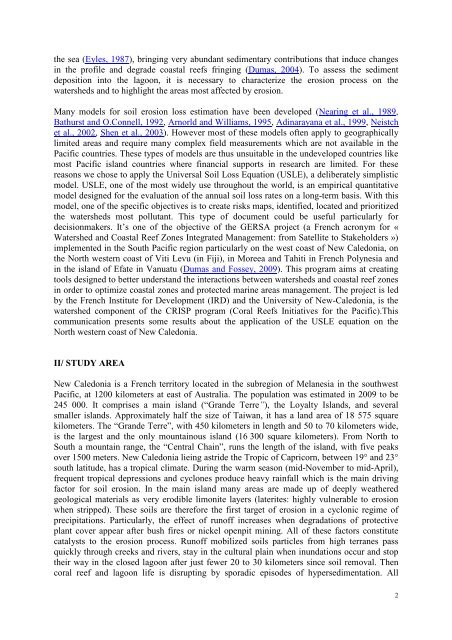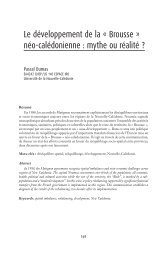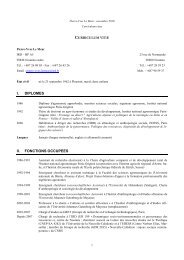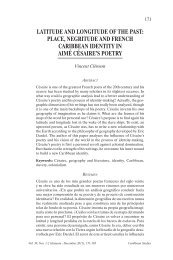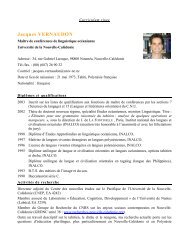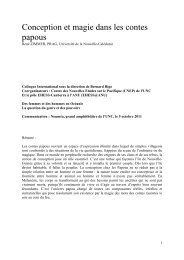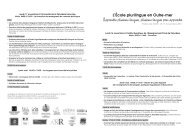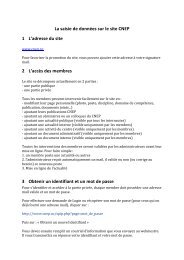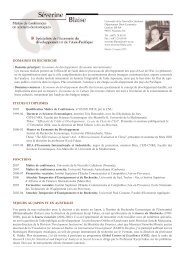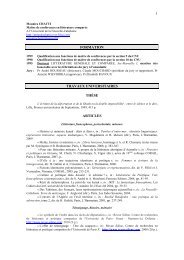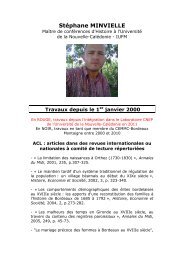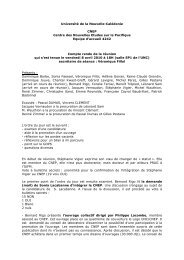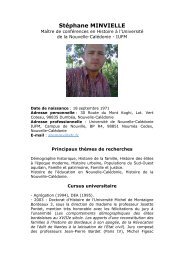assessment of soil erosion using usle model and gis for integrated ...
assessment of soil erosion using usle model and gis for integrated ...
assessment of soil erosion using usle model and gis for integrated ...
Create successful ePaper yourself
Turn your PDF publications into a flip-book with our unique Google optimized e-Paper software.
the sea (Eyles, 1987), bringing very abundant sedimentary contributions that induce changesin the pr<strong>of</strong>ile <strong>and</strong> degrade coastal reefs fringing (Dumas, 2004). To assess the sedimentdeposition into the lagoon, it is necessary to characterize the <strong>erosion</strong> process on thewatersheds <strong>and</strong> to highlight the areas most affected by <strong>erosion</strong>.Many <strong>model</strong>s <strong>for</strong> <strong>soil</strong> <strong>erosion</strong> loss estimation have been developed (Nearing et al., 1989,Bathurst <strong>and</strong> O.Connell, 1992, Arnorld <strong>and</strong> Williams, 1995, Adinarayana et al., 1999, Neistchet al., 2002, Shen et al., 2003). However most <strong>of</strong> these <strong>model</strong>s <strong>of</strong>ten apply to geographicallylimited areas <strong>and</strong> require many complex field measurements which are not available in thePacific countries. These types <strong>of</strong> <strong>model</strong>s are thus unsuitable in the undeveloped countries likemost Pacific isl<strong>and</strong> countries where financial supports in research are limited. For thesereasons we chose to apply the Universal Soil Loss Equation (USLE), a deliberately simplistic<strong>model</strong>. USLE, one <strong>of</strong> the most widely use throughout the world, is an empirical quantitative<strong>model</strong> designed <strong>for</strong> the evaluation <strong>of</strong> the annual <strong>soil</strong> loss rates on a long-term basis. With this<strong>model</strong>, one <strong>of</strong> the specific objectives is to create risks maps, identified, located <strong>and</strong> prioritizedthe watersheds most pollutant. This type <strong>of</strong> document could be useful particularly <strong>for</strong>decisionmakers. It’s one <strong>of</strong> the objective <strong>of</strong> the GERSA project (a French acronym <strong>for</strong> «Watershed <strong>and</strong> Coastal Reef Zones Integrated Management: from Satellite to Stakeholders »)implemented in the South Pacific region particularly on the west coast <strong>of</strong> New Caledonia, onthe North western coast <strong>of</strong> Viti Levu (in Fiji), in Moreea <strong>and</strong> Tahiti in French Polynesia <strong>and</strong>in the isl<strong>and</strong> <strong>of</strong> Efate in Vanuatu (Dumas <strong>and</strong> Fossey, 2009). This program aims at creatingtools designed to better underst<strong>and</strong> the interactions between watersheds <strong>and</strong> coastal reef zonesin order to optimize coastal zones <strong>and</strong> protected marine areas management. The project is ledby the French Institute <strong>for</strong> Development (IRD) <strong>and</strong> the University <strong>of</strong> New-Caledonia, is thewatershed component <strong>of</strong> the CRISP program (Coral Reefs Initiatives <strong>for</strong> the Pacific).Thiscommunication presents some results about the application <strong>of</strong> the USLE equation on theNorth western coast <strong>of</strong> New Caledonia.II/ STUDY AREANew Caledonia is a French territory located in the subregion <strong>of</strong> Melanesia in the southwestPacific, at 1200 kilometers at east <strong>of</strong> Australia. The population was estimated in 2009 to be245 000. It comprises a main isl<strong>and</strong> (“Gr<strong>and</strong>e Terre”), the Loyalty Isl<strong>and</strong>s, <strong>and</strong> severalsmaller isl<strong>and</strong>s. Approximately half the size <strong>of</strong> Taiwan, it has a l<strong>and</strong> area <strong>of</strong> 18 575 squarekilometers. The “Gr<strong>and</strong>e Terre”, with 450 kilometers in length <strong>and</strong> 50 to 70 kilometers wide,is the largest <strong>and</strong> the only mountainous isl<strong>and</strong> (16 300 square kilometers). From North toSouth a mountain range, the “Central Chain”, runs the length <strong>of</strong> the isl<strong>and</strong>, with five peaksover 1500 meters. New Caledonia lieing astride the Tropic <strong>of</strong> Capricorn, between 19° <strong>and</strong> 23°south latitude, has a tropical climate. During the warm season (mid-November to mid-April),frequent tropical depressions <strong>and</strong> cyclones produce heavy rainfall which is the main drivingfactor <strong>for</strong> <strong>soil</strong> <strong>erosion</strong>. In the main isl<strong>and</strong> many areas are made up <strong>of</strong> deeply weatheredgeological materials as very erodible limonite layers (laterites: highly vulnerable to <strong>erosion</strong>when stripped). These <strong>soil</strong>s are there<strong>for</strong>e the first target <strong>of</strong> <strong>erosion</strong> in a cyclonic regime <strong>of</strong>precipitations. Particularly, the effect <strong>of</strong> run<strong>of</strong>f increases when degradations <strong>of</strong> protectiveplant cover appear after bush fires or nickel openpit mining. All <strong>of</strong> these factors constitutecatalysts to the <strong>erosion</strong> process. Run<strong>of</strong>f mobilized <strong>soil</strong>s particles from high terranes passquickly through creeks <strong>and</strong> rivers, stay in the cultural plain when inundations occur <strong>and</strong> stoptheir way in the closed lagoon after just fewer 20 to 30 kilometers since <strong>soil</strong> removal. Thencoral reef <strong>and</strong> lagoon life is disrupting by sporadic episodes <strong>of</strong> hypersedimentation. All2


